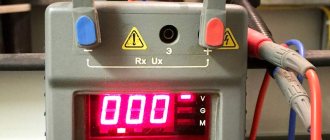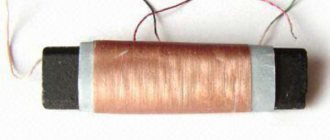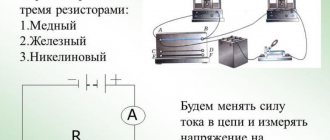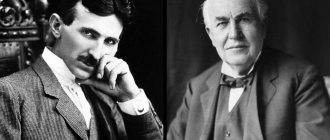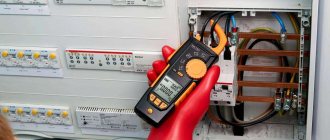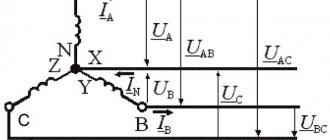Electricity itself is invisible, although this makes it no less dangerous. On the contrary: that is precisely why it is more dangerous. After all, if we saw it, as we see, for example, water pouring from a tap, we would certainly avoid a lot of trouble.
Water. Here it is, a water pipe, and here is a closed tap. Nothing flows, nothing drips. But we know for sure: there is water inside. And if the system is working properly, then the water there is under pressure. 2, 3 atmospheres, or how many there? Doesn't matter. But there is pressure there, otherwise the system would not work. Somewhere, pumps are humming, pumping water into the system, creating this same pressure.
But our electrical wire. Somewhere far away, at the other end, generators are also humming, generating electricity. And there is also pressure in the wire from this... No, no, not pressure, of course, there is voltage
. It is also measured, but in its own units: volts.
The water in the pipes presses against the walls, not moving anywhere, waiting for a way out to be found so that it can rush there in a powerful stream. And in the wire, the voltage silently waits for the switch to close so that the flow of electrons can move to fulfill their purpose.
And then the tap opened and a stream of water flowed. It flows throughout the pipe, moving from the pump to the flow valve. And as soon as the switch contacts closed, electrons flowed into the wires. What kind of movement is this? This is the current
.
Electrons flow
. And this movement, this current also has its own unit of measurement: ampere.
And there's still resistance
. For water, this is, figuratively speaking, the size of the hole in the outlet tap. The larger the hole, the less resistance to water movement. It’s almost the same in wires: the greater the resistance of the wire, the less the current.
This is something like this, if you figuratively imagine the main characteristics of electricity. But from the point of view of science, everything is strict: there is the so-called Ohm’s law. It reads as follows: I = U/R
.
I
is the current strength.
Measured in amperes. U
is voltage.
Measured in volts. R
- resistance. Measured in ohms.
There is one more concept - power, W. It’s also simple: W = U*I
. Measured in watts.
Actually, this is all the necessary and sufficient theory for us. From these four units of measurement, in accordance with the above two formulas, a number of others can be derived:
| № | Task | Formula | Example |
| 1 | Find out the current strength if the voltage and resistance are known. | I = U/R | I = 220 V / 500 ohm = 0.44 A. |
| 2 | Find out the power if the current and voltage are known. | W = U*I | W = 220 V * 0.44 A = 96.8 W. |
| 3 | Find out the resistance if the voltage and current are known. | R = U/I | R = 220 V / 0.44 A = 500 ohm. |
| 4 | Find out the voltage if the current and resistance are known. | U = I*R | U = 0.44 a * 500 ohm = 220 v. |
| 5 | Find out the power if the current and resistance are known. | W = I 2 *R | W = 0.44 a * 0.44 a * 500 ohm = 96.8 watts. |
| 6 | Find out the power if the voltage and resistance are known. | W=U2/R | W = 220 V * 220 V / 500 ohm = 96.8 W. |
| 7 | Find out the current strength if the power and voltage are known. | I = W/U | I = 96.8 W / 220 V = 0.44 A. |
| 8 | Find out the voltage if the power and current are known. | U = W/I | U = 96.8 W / 0.44 A = 220 V. |
| 9 | Find out the resistance if the power and voltage are known. | R = U 2 /W | R = 220 V * 220 V / 96.8 W = 500 ohm. |
| 10 | Find out the resistance if the power and current are known. | R = W/I 2 | R = 96.8 W / (0.44 A * 0.44 A) = 500 ohm. |
You say: “Why do I need all this?” Formulas, numbers... I'm not going to do calculations.
And I will answer this: - Re-read the previous article. How can you be sure without knowing the simplest truths and calculations? Although, in fact, in everyday practical terms, only formula 7 is most interesting, where the current strength is determined at a known voltage and power. As a rule, these 2 quantities are known, and the result (current strength) is certainly necessary to determine the permissible cross-section of the wire and to select protection.
There is one more circumstance that should be mentioned in the context of this article. The electric power industry uses so-called “alternating” current. That is, those same electrons do not always move in the same direction in the wires, they constantly change it: forward-backward-forward-backward... And this change in direction of movement is 100 times per second.
Wait, but everywhere they say that the frequency is 50 hertz! Yes, that's exactly what it is. Frequency is measured in the number of cycles per second, but in each cycle the current changes direction twice. In other words, in one period there are two peaks that characterize the maximum value of the current (positive and negative), and it is at these peaks that the direction changes.
We will not go into details more deeply, but still: why alternating current and not direct current?
The whole problem is the transmission of electricity over long distances. This is where Ohm’s inexorable law comes into force. Under heavy loads, if the voltage is 220 volts, the current can be very high. To transmit electricity with such a current, very large cross-section wires will be required.
There is only one way out: increase the voltage. The seventh formula says: I = W/U
. It is quite obvious that if we supply a voltage not of 220 volts, but of 220 thousand volts, then the current strength will decrease a thousand times. This means that the cross-section of the wires can be taken much smaller.
Site search. You can change your search phrase.
Electric current can be compared to how water flows in a pipe, and voltage to the level of this water. An electric current passing through a pipe does a certain amount of work. Based on the definition, power is work per unit of time or the rate at which work is performed.
In one second, a certain amount of electricity flows through the cross-section of the circuit. This concept will be called current strength. Therefore, there will be a directly proportional relationship between power, current and voltage.
Formulas for calculating current power
Electrical power is measured in watts (W). A current of 1A and a voltage of 1V has a power of 1W. In order to find out how to determine the current power, you need to use the following formula: P=U*I (A), where U, I are the electric field voltage and current strength, respectively, and P is its power.
To understand how to use the formula correctly, let's look at a small example. Let's say a voltage of 150V is applied to a resistor and a current of 0.2A flows through it. What power develops on this resistor? P=150*0.2=30W.
There is another way to calculate the power of an electric current. If the circuit resistance and current strength are known, then it is necessary to use Ohm’s law (the formula is applicable for the circuit section): U=I*R (B)
Now let's substitute formula (B) into formula (A) and get formula (B): P=I 2 R (B). Let us assume that a current of 0.5A passes through a rheostat, the resistance of which is 5 Ohms. Determine the power that is lost in the rheostat? P=0.5 2 *5=1.25W.
If the current strength is unknown to us, but we know the voltage and resistance, then it is also possible to determine the power. From Ohm's law I=U/R, then using formula (A) the current power is equal to: P=U 2 /R (G)
The rheostat has a resistance of 5 Ohms, and the voltage in it is 2.5V, then the power according to formula (G) will be equal to: P = 2.5 2 /5 = 1.25 W. If you know any two values from the formula for Ohm's law (if you consider a section of the circuit), then you can always determine the current power.
Remembering the definition of power, we can write down another formula for its calculation: P=A/t (D), where P is power, A is the work of electric current, and t is the time during which this work is performed.
When choosing a particular household appliance in a store, we often wonder how much money we will have to pay for its use. This is especially true for a heater that runs on electricity. Sometimes, when using a welding machine or an electric motor, we are not even aware of how much electricity it consumes. But how can we find out the numbers we need if the data on the devices is not known?
Types of friction force
There are different types of resistance forces:
- rolling friction force \(P_f\). Depends on the type and structure of the support surface, the speed of movement of the body, environmental pressure and other factors. The rolling resistance coefficient \(f\) depends on the type and condition of the support surface, and is inversely proportional to temperature and pressure.
- air friction force (drag) \(P_vl\). Appears due to pressure differences. This indicator depends on the vortex formations around the object of movement, which in turn depend on the shape of the moving object.
Resistance will be more significantly affected by moving the front of the object. Thus, by forming a curve at the front and back of the object, the resistance value can be reduced by up to 72%. The drag force is calculated as follows:
\(P_vl=c_x pF_v {v^2\over 2},\)
where \(c_x\) is the coefficient of streamlining or drag; \(p\) – density of the medium; \(F_в\) – drag area (midship section). The air friction force is directed opposite to the velocity vector of the body. It is considered as a concentrated force applied to the center of windage of the body, which may not coincide with its center of gravity.
Is it difficult to figure it out on your own?
Try asking your teachers for help
Solving problems Tests Essays
According to Newton's second law, the force of resistance to the acceleration of a body performing translational motion is determined as follows:
\(P_j=m {dv\over dt},\)
where \(m\) is the mass of the object; \({dv\over dt}\) – acceleration of the center of mass.
Power consumption of electrical appliances: table with indicators
To carry out calculations, you need basic knowledge of electrodynamics from the school course related to power, voltage, current. In order to calculate the power consumption of the device, it is necessary to know the voltage value, as well as the strength of the source. Power (P) can be calculated by multiplying the current strength by the electrical voltage in the network.
Current strength is usually called the amount of electric charge passing through a given network area per unit of time. A physical quantity characterized by an electric field that creates a current is voltage.
The following indicators are used:
- Many volt-amperes are sometimes used as a non-system unit of power;
- In this case, the power is indicated in circuit breakers.
It is true that it is the maximum value at which the breaker trips.
Determination of power source power: calculation methods
To obtain this indicator, you will need the values of current, denoted as (I) and voltage, written as (V) power supply. To calculate power (P), you need to multiply these two values together. This current strength is the amount of charge that passes through a certain surface in a certain period of time. Voltage is a variable quantity that characterizes the electric field created by current.
The approximate power of the device is equal to the product of voltage and current. The formula looks like P = I x V.
Usually:
- The current strength is indicated on the circuit breakers;
- The specified value is the maximum current at which the breaker turns on;
- The voltage and current values are usually indicated on the body of the electrical appliance or heating element.
If it is not there, then you should look in the documentation for it.
Summarize
When two or more resistors are connected such that both terminals of one resistor are connected to the corresponding terminals of another resistor or resistors, they are said to be connected in parallel. The voltage across each resistor within a parallel combination is the same, but the currents flowing through them may differ from each other, depending on the value of the resistance of each resistor.
The equivalent or total resistance of a parallel combination will always be less than the minimum resistance of the resistor included in the parallel connection.
How to calculate the electricity consumption of the device
The current indicator, as well as the voltage of some common electrical appliances, is available in specialized reference books. If you don’t have them, then make a request and find them on the Internet or online resources.
The current strength is calculated using a similar formula as the voltage. To do this, the available quantities need to be divided.
For example, you need to calculate how much power a TV, ceiling fan, or microwave oven consumes, while such an indicator as their current strength is indicated on the device body. To be able to make a calculation, you need to find the fan voltage and resistance. You can find it out on the Internet or from the manufacturer. Then, by substituting the values into the formula, you can easily calculate the fan power.
What you need to know about power:
- Power is the rate at which required energy is converted, transmitted, or consumed. Typically, you pay for electricity according to the power consumed.
- Power is measured in watts (W).
- The power of an electrical appliance is an indicator of the energy that the device consumes.
- Rated power is the required value necessary for the correct operation of the device.
- Current can be constant or alternating. Alternating current can change in magnitude or direction. It is supplied via electrical networks. Definition: Direct current does not change in direction or magnitude. The source of such current can be called an accumulator or battery.
Starting power is the unit required to start an engine or compressor.
How to find the resistance force
When any object moves on a surface or in the air, forces arise that prevent it. They are called resistance or friction forces. In this article we will tell you how to find the drag force and look at the factors that influence it.
1
To determine the resistance force, it is necessary to use Newton's third law. This value is numerically equal to the force that must be applied to make an object move evenly on a flat horizontal surface. This can be done using a dynamometer.
2
The resistance force is calculated by the formula F=μ*m*g. According to this formula, the desired value is directly proportional to body mass. It is worth considering that for correct calculation it is necessary to select μ - a coefficient that depends on the material from which the support is made. The material of the item is also taken into account. This coefficient is selected according to the table. For the calculation, the constant g is used, which is equal to 9.8 m/s2.
3
How to calculate resistance if the body does not move in a straight line, but along an inclined plane? To do this, you need to enter the cos of the angle into the initial formula. It is the angle of inclination that determines the friction and resistance of the surface of bodies to movement. The formula for determining friction on an inclined plane will look like this: F=μ*m*g*cos(α).
4
If a body moves at a height, then the air friction force acts on it, which depends on the speed of the object. The required value can be calculated using the formula F=v*α. Where v is the speed of movement of the object, and α is the drag coefficient of the medium. This formula is only suitable for bodies that move at low speeds. To determine the drag force of jet aircraft and other high-speed units, another is used - F=v2*β. To calculate the friction force of high-speed bodies, use the square of the speed and the coefficient β, which is calculated for each object separately. When an object moves in a gas or liquid, when calculating the friction force, it is necessary to take into account the density of the medium, as well as the mass and volume of the body.
5
Traffic resistance significantly reduces the speed of trains and cars. Moreover, two types of forces act on moving objects - permanent and temporary. The total friction force is represented by the sum of two quantities. To reduce drag and increase machine speed, designers and engineers invent a variety of materials with a sliding surface from which air is repelled. That is why the front part of high-speed trains has a streamlined shape. Fish move very quickly in the water thanks to a streamlined body covered with mucus, which reduces friction.
6
The force of resistance does not always have a negative effect on the movement of cars. To pull a car out of the mud, you need to pour sand or crushed stone under the wheels. Thanks to the increase in friction, the car copes well with swampy soil and mud.
Airborne resistance is used during skydiving. As a result of the friction between the canopy and the air, the parachutist's speed is reduced, which allows him to engage in parachuting without harming his life.
Let's look at how a power meter works in a socket
If you need to find out how much power a particular item has, you can measure the current and voltage using a multimeter, and then simply multiply them. There are also devices that measure power. They are called wattmeters. The power indicator is calculated by the built-in calculator, and the indicator immediately appears on its display.
How to use a wattmeter and multimeter:
- We insert the device into a 220V socket;
- We insert the plug of the device that we need to measure into the wattmeter;
- We are waiting for the required indicator to appear on the display.
On the back panel of the device there is a compartment for batteries, which are usually included in the kit. On the plate next to it there is information with the characteristics of the wattmeter itself, its number, as well as the plug. There is a display on the outside. Control is carried out by 4 buttons, near which there is a socket for connecting household appliances, equipment and appliances.
When the device is turned on, 3 information lines appear on its screen, like a meter: one graphic and two digital.
Using the fourth Value button you can switch and define the following measured parameters:
- Mains voltage;
- The power consumed by the connected device;
- The current consumed by the device.
When a limit value is set regarding voltage and current, one of the characteristics the device will give a signal. This means overload.
Is it possible to calculate electricity consumption knowing the approximate power
When making your own calculations, do not forget about the small power that some devices consume even when they are not working, but are connected to an outlet. It also needs to be counted. Many appliances are equipped with an indicator, or they have an LED, which can also consume some power.
Awareness of the power consumption of the device makes it possible to significantly save energy.
Calculations are made as follows:
- When calculating power according to the formula, you get an approximate value.
- In the case when you need an accurate indicator of power, it is better to use a wattmeter. Any power, be it electrical, thermal or mechanical, is measured in watts. In order to be able to save energy, it is important to know their power consumption by devices.
- To calculate the difference between two powers, subtract one such value from the other.
When you pay your electricity bill, you are essentially paying for every kilowatt you use. To convert watts to kilowatts, you need to divide one watt reading by 1000, and then multiply the resulting kilowatt value by the number of hours worked by the device. As a result, you will get the required value, existing as (kWh). If you multiply it by the cost of 1 kilowatt of electricity, you can find out how much you will have to pay to operate the device. For example, if there are only 10 light bulbs in your house or apartment and 100 W is the power consumed by each lamp, then after calculating we will get 10 x 100, resulting in 1000 W - the total power of all lamps. If you divide 1000 W by 1000, you get 1 kW. Now it is not difficult to calculate that if the light bulbs burned for 2000 hours a year, and one kilowatt per hour costs 6 rubles. Then, for a year you will have to pay 12,000 rubles.
Example No. 1
When developing the device, it became necessary to install a resistor with a resistance of 8 ohms. If we look at the entire nominal range of standard resistor values, we will see that there is no resistor with a resistance of 8 ohms.
The way out of this situation is to use two parallel connected resistors. The equivalent resistance value for two resistors connected in parallel is calculated as follows:
Hantek 2000 - 3 in 1 oscilloscope
Portable USB oscilloscope, 2 channels, 40 MHz….
More details
This equation shows that if R1 is equal to R2, then the resistance R is half the resistance of one of the two resistors. With R = 8 ohms, R1 and R2 must therefore have a value of 2 × 8 = 16 ohms. Now let's check by calculating the total resistance of the two resistors:
Thus, we obtained the required resistance of 8 ohms by connecting two 16 ohm resistors in parallel.
Voltage drop calculation
Any conductor, except superconductors, has resistance. Therefore, if the cable or wire is long enough, a voltage drop occurs. PES standards require that the cross-section of the cable core be such that the voltage drop is no more than 5%.
This primarily concerns low-voltage cables of small cross-section. The voltage drop calculation is as follows:
R = 2*(ρ * L) / S
U pad = I * R
U% = (U pad / U line) * 100
2 – coefficient due to the fact that the current necessarily flows through two wires
R – conductor resistance, Ohm
ρ—conductor resistivity, Ohm*mm 2 /m
S – conductor cross-section, mm 2
U pad – drop voltage, V
U% - voltage drop relative to U line,%
Table 9. Resistivity of common metal conductors (+)
Ohm's Law - calculator
This online Ohm's Law calculator allows you to determine the relationship between current strength, electrical voltage, conductor resistance and power. To calculate, enter any two parameters and click the calculate button:
To consolidate our understanding of how Ohm’s law works, we present several tasks for you to solve on your own.
| What should be the minimum power of this resistor? Answer: According to the pie chart, P = I2*R = 0.12*50 = 0.5 W. Thus, the minimum power should be at least 0.5 W, but it is recommended to take a more powerful one for additional reliability and durability. |
| What will be the current in the circuit? Answer: This is a simple example of Ohm's law. The voltage and resistance are known, so we can calculate the current using the formula: I = V / R = 6 / 1.2 = 5 A. |
| An electric heater (resistor) with a power of 1 kW is connected to a circuit with a current of 10A. What will be the voltage drop across the heater? Answer: Voltage can be expressed in terms of current and power using the formula: V = P / I = 1000/10 = 100 V |
